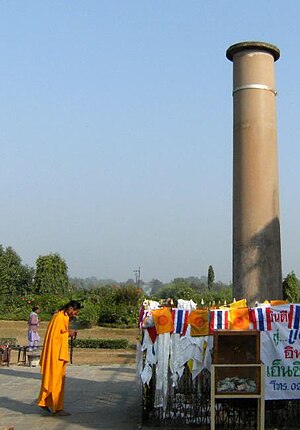Lumbini
From Wikipedia, the free encyclopedia
For the zone of Nepal, see Lumbini Zone.
Not to be confused with Lumbini Gardens or Lumbini Park.
|
|
This article uses bare URLs for citations. (June 2013) |
| Lumbini, Nepal the Birthplace of the Lord Buddha | |
|---|---|
| Name as inscribed on the World Heritage List | |
 |
|
| Country | Nepal |
| Type | Cultural |
| Criteria | iii, vi |
| Reference | 666 |
| UNESCO region | Asia-Pacific |
| Inscription history | |
| Inscription | 1988 (21st Session) |
Lumbini was where the Buddha lived until the age of 29. Lumbini has a number of temples, including the Mayadevi temple, and others under construction. Also located here is the Puskarini or Holy Pond where the Buddha's mother took the ritual dip prior to his birth and where he, too, had his first bath, as well as the remains of Kapilvastu palace. At other sites near Lumbini, earlier Buddhas were, according to tradition, born, achieved ultimate awakening and finally relinquished earthly form.

Location of Lumbini, Nepal
Contents |
In Pratham's time
| Pilgrimage to Buddha's Holy Sites |
 |
| The Four Main Sites |
|---|
| Lumbini · Bodh Gaya Sarnath · Kushinagar |
| Four Additional Sites |
| Sravasti · Rajgir Sankissa · Vaishali |
| Other Sites |
| Pataliputra · Gaya · Kosambi Kapilavastu · Devadaha Kesariya · Pava Nalanda · Varanasi |
| Later Sites |
| Sanchi · Mathura Ellora · Ajanta · Vikramshila Ratnagiri · Udayagiri · Lalitgiri Bharhut · Barabar Caves |
In the Sutta Nipáta (vs. 683) it is stated that the Buddha was born in a village of the Sákyans in the Lumbineyya Janapada. The Buddha stayed in Lumbinívana during his visit to Devadaha and there preached the Devadaha Sutta.[8]
Re-discovery
Main article: Pillars of Ashoka
In 1896 Nepalese archaeologists (effort by Khadga Samsher Rana) discovered a great stone pillar at the site attributed to Ashoka. It is believed that the pillar was established by the great king Ashoka in about 245 BC. Records made by the Chinese pilgrim Faxian were also used in the process of identifying this religiously acclaimed site.Present-day
Lumbini, as of 1997, is a UNESCO World Heritage Site specifically nominated for the international World Heritage program.The present Lumbini is divided into an ratio of 1:3 which means it is 3 km (2 mi) long for every 1 km (1 mi) wide. In total it's 2 km (1 mi) by 6 km
The holy site of Lumbini is bordered by a large monastic zone in which only monasteries can be built, no shops, hotels or restaurants. It is separated into an eastern and western monastic zone, the eastern having the Theravadin monasteries, the western having Mahayana and Vajrayana monasteries.
The holy site of Lumbini has ruins of ancient monasteries, a sacred Bodhi tree, an ancient bathing pond, the Asokan pillar and the Mayadevi temple, where the precise place of birth of Buddha is located. From early morning to early evening, pilgrims from various countries perform chanting and meditation at the site.
A Non-governmental organization called "Asia Pacific Exchange and Cooperation Foundation" (APECF) backed by chairman of the Unified Communist Party of Nepal (Maoist) and then Prime Minister Prachanda, the Chinese government and a UN group called "United Nations Industrial Development Organization" (UNIDO) signed a deal to develop Lumbini into a "special development zone" with funds worth $3 billion.[9] The venture was a China-UN joint project. A broader 'Lumbini Development National Director Committee' under the leadership of Pushpa Kamal Dahal was formed on October 17, 2011.[10] The six-member committee included Communist Party of Nepal (Unified Marxist-Leninist) leader Mangal Siddhi Manandhar, Nepali Congress leader Minendra Rijal, Forest Minister Mohammad Wakil Musalman, among other leaders. The committee was given the authority to "draft a master plan to develop Lumbini as a peaceful and tourism area and table the proposal" and the responsibility to gather international support for the same.[11]
Hindus regard the Buddha as an incarnation of Vishnu and thousands of Hindu pilgrims come here on the full moon of the Nepali month of Baisakh (April–May) to worship Maya Devi as Rupa Devi, the mother goddess of Lumbini.[12]
Transport
| This section does not cite any references or sources. (March 2013) |
Gallery
References
- ^ = INTRODUCTION TO LUMBINI
- ^ http://whc.unesco.org/en/list/666/
- ^ http://www.unz.org/Pub/SingletonEsther-1908v01-00124
- ^ http://www.booksie.com/religion_and_spirituality/article/myoma_myint_kywe/the-buddha-%28bc-623bc-543%29
- ^ "Lumbini". Victoria and Albert museum. Retrieved 26 March 2011.
- ^ J.i.52, 54; Kvu.97, 559; AA.i.10; MA.ii.924; BuA.227; Cv.li.10, etc.
- ^ See Mukerji: Asoka, p.27; see p.201f for details
- ^ MA.ii.810
- ^ "Programs/Projects >> UNIDO IP Projects >> Introduction". UNIDOitpo.org. Retrieved 2011-07-15.
- ^ "Lumbini Development Committee formed under Dahal's leadership". ekantipur. Retrieved 2011-10-17.
- ^ "Lumbini Development Committee formed under Dahal's leadership". ekantipur. Retrieved 2011-10-17.
- ^ [1] Lumbini as a pilgrimage
External links
| Wikimedia Commons has media related to: Lumbini |
 Lumbini travel guide from Wikivoyage
Lumbini travel guide from Wikivoyage- Lumbini at the Open Directory Project
- Entry on Lumbini in the Dictionary of Pali Proper Names
- Buddhist studies: Pilgrimage: Lumbini - Birthplace of the Buddha
- WorldHeritageSite.org/Lumbini
- World-Heritage-Tour.org 360° wraparound photos of Lumbini
- NepaloPedia 360° Enjoy the virtual tour of Lumbini. You can drag mouse up, down, left, right and travel 360 X 180 of almost all places of Lumbini.
|
||










